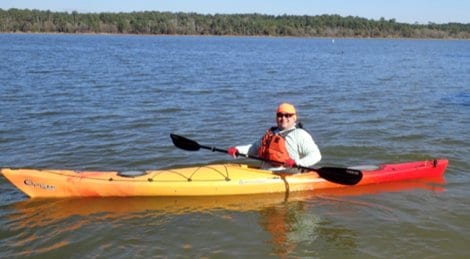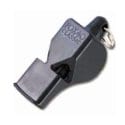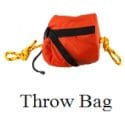 By Bob Currie, Recreational Boating Safety Specialist
By Bob Currie, Recreational Boating Safety Specialist
United States Coast Guard Auxiliary Station Galveston Flotilla
If you are one of the many people who received a kayak for Christmas, congratulations! This column is dedicated to giving you information on how to get started with operating safely on the water.
The Station Galveston Flotilla of the US Coast Guard Auxiliary operates out of the USCG Station Galveston base on Galveston Island. They aid the Coast Guard by providing maritime observation patrols in Galveston Bay; by providing recreational boating vessel safety checks; and by working alongside Coast Guard members in maritime accident investigation, small boat training, Aids to Navigation verification, and watch standing.
Coast Guard Auxiliary Paddlecraft Specialist
The US Coast Guard has tasked the Auxiliary with increasing our outreach to Paddlecraft operators. In answer to that request, one of the Galveston Flotilla members, Jay Hrivnatz, has undergone extensive American Canoe Association (ACA) training to become a Level 2 certified sit on top paddler and has completed all the requirements to become an Auxiliary Paddlecraft (AUXPAD) Specialist. Jay is also a certified Coast Guard Communications Watchstander. If you ever find yourself calling the Coast Guard for assistance, Jay might well be the person who answers your call for help. Below is a pic of Jay in one of his kayaks. I had the pleasure of certifying another of his kayaks as a Coast Guard Operational Facility (OPFAC), making his kayak an official Coast Guard vessel.

Jay wanted me to point out that he is wearing a full wet suit under his clothing. One of the most important aspects of safe kayaking is to always dress for immersion.
Free Paddle Sports Safety Course
I highly recommend that all paddle craft operators take a paddle craft course. Here is a link to a free online Coast Guard recognized course that one may take and receive certification: ttps://www.boaterexam.com/paddling/
Take a Paddle Class
While an online paddling course is quite useful, nothing beats hands on instruction from a certified instructor. You will learn and practice the skills that make paddling safe and enjoyable. You will learn good paddling technique from certified instructors. Check with your local paddle shop for a list of paddle classes in your area. You can also find a list of ACA-certified instructors at:
americancanoe.org/instruction.
Personal Flotation Device (PFD)
The requirements for a personal flotation device (life jacket) are the same as those for a powerboat or sailboat. There must be one Coast Guard approved PFD, adjusted to the wearer, and immediately available. It is always important to wear your PFD when in, on and around the water. This is especially true in the case of small boats or paddlecraft due to the increased chance of capsizing. A canoe or kayak can capsize even in calm waters. According to the U.S. Coast Guard statistics at least 90% of people who drown in boating accidents were not wearing a PFD at the time. PFDs can save lives, but only when worn. Although not required, it is always a good idea to have a Type IV Throwable Device onboard for use in an emergency. All occupants less than 13 years of age must wear a Type I, II, or Type III PFD when not at the dock under Texas regulations.
Sound Signal
Operators of non-motorized boats are required to have some means of making a detectable oral or mechanical sound signal that can be heard from no less than one-half mile away, such as a whistle or a horn.  Ideally it is attached to your life jacket. Although just about any whistle will do, a pea-less whistle is highly recommended. Old style whistles have a ball-shaped piece of cork in them that helps make the whistle loud. That piece of cork deteriorates quickly when it is exposed to water. Newer models such as the Fox40 whistle do not have a pea and are not affected by immersion in water.
Ideally it is attached to your life jacket. Although just about any whistle will do, a pea-less whistle is highly recommended. Old style whistles have a ball-shaped piece of cork in them that helps make the whistle loud. That piece of cork deteriorates quickly when it is exposed to water. Newer models such as the Fox40 whistle do not have a pea and are not affected by immersion in water.
Pump or Bailer
This recommendation applies to sit inside paddlecraft (canoes and kayaks). Wave action, even on a relatively calm day, is likely to enter a sit inside paddlecraft, and swamping of such craft is almost a given in the open seas. Living at the beach, I see this daily during the summer months. I would never recommend a canoe for use in the surf, but they are out there. If you just have to put that canoe or sit inside kayak in the Gulf of Mexico, be sure to have some means of bailing the water out, and make sure your bail is fastened to the craft so that it doesn’t float away.
Spray Skirt
I have both a sit inside and a sit on top kayak. I will launch my sit inside kayak in the bay on occasion. It has internal flotation but can still be swamped to the point where it is not maneuverable. To prevent that from happening, I use a spray skirt that makes a seal between me and the body of the kayak. The spray skirt does prevent water from entering the kayak, but it also makes exiting the kayak in the event of being capsized a very difficult process. If you use a spray skirt, you need to practice extricating yourself from a capsized kayak, preferably in a swimming pool with someone to help you if you get into trouble. Spray skirts have a grab loop on them to help with the extrication process, but you must make sure that it is not tucked into the skirt each time you use it.
Spare Paddle/Oars
This recommendation is for all paddle craft whose operators plan to venture far from shore. I was on a 4-mile paddle offshore once when one of my paddle blades split. I had a spare paddle on board. Otherwise, it was going to be a rough paddle back to shore with a one-bladed kayak paddle. It is also important to have a safety line attached to your paddle. It is so easy for a paddle to slip off into the water and float quickly out of reach or even sink. I also use safety lines on my fishing rods and tackle box. Those can disappear just as easily when a rogue wave rocks your paddle craft.
Compass/GPS
If you venture out far enough into the gulf, you will lose sight of land. Please don’t use the sun for navigation. It doesn’t work well at all. You should have a compass at the least and take a heading on that compass as you depart the shore. Many a navigator has failed to take notice that the land mass he is searching for runs more north to south than east to west and paddled parallel to the shore rather than back to it. A GPS is nice to have, but electronics can fail, especially when they are constantly exposed to waves breaking over the paddle craft. You can’t use the direction of the waves as a reliable guide back to shore either, as they also can run parallel to the beach. There are several smart phone GPS apps out there that turn your cell phone into a GPS. You may want to try one of those first.
Kayak Throw Bag
A throw bag is a bag that contains a coiled rope that can be used to rescue a boat or a person in the water. Throwing a bag from the cockpit of a sea kayak is a little different than throwing one from the shore, especially when trying to juggle a paddle and waves. The best throw is overhand, and it’s often helpful to clip the end of throw bag’s line to your kayak.  Clipping it to your kayak relieves you of worrying about losing it as you toss it out. Often having a partner raft up for stability will allow you to throw the rope much further. A throw bag is most useful to rescue someone who has ventured too close to the rocks and is in danger of being tossed onto the rocks. Rather than kayaking in close to effect a rescue, the rescuer can help preserve his or her own safety by throwing a tow bag to the person in danger. Sitting down in the kayak also makes it harder to get a good throw. Expect the throw to land 30 to 35 feet away from you. This is something you’ll want to practice before having to use it in a real situation.
Clipping it to your kayak relieves you of worrying about losing it as you toss it out. Often having a partner raft up for stability will allow you to throw the rope much further. A throw bag is most useful to rescue someone who has ventured too close to the rocks and is in danger of being tossed onto the rocks. Rather than kayaking in close to effect a rescue, the rescuer can help preserve his or her own safety by throwing a tow bag to the person in danger. Sitting down in the kayak also makes it harder to get a good throw. Expect the throw to land 30 to 35 feet away from you. This is something you’ll want to practice before having to use it in a real situation.
Once you have contact with the swimmer, they should turn their boat right-side up and either clip the rope to their boat or hang on to both the rope and their kayak as they’re pulled to safety. The rescuer can retrieve the rope while pulling the paddler out or tow the kayaker out by having the rope clipped to the kayak. Keep in mind re-stuffing a throw bag while retrieving the rope leaves the swimmer in danger longer and having loose rope near you puts you in danger.
Throw Bag
Swimming Skills and Life Jackets
Although paddlecraft operators aren’t required to be skilled swimmers, they are strongly urged to improve their swimming ability. With paddle craft, sudden immersion in water is not a rarity. Boaters should always wear U.S. Coast Guard approved life jackets that are designed for the specific activity. The PFD I use when paddling has large cutouts for my arms, which makes paddling much easier. If you cannot swim well, you should not use paddle craft without close supervision. Paddle craft operators should regularly practice their skills in exiting and entering their boats, preferably under the same conditions in which they plan to use the craft.
Prepare for the Worst
Paddle craft operators should carry whatever equipment will be needed to cope with the worst situation they are apt to encounter on a specific trip, including a life jacket, throw bag, towline, compass, signaling devices, sponge, bailer, spare paddle, gloves, sun glasses, and a hat with a brim. Always dress for an unexpected capsize, and wear a helmet where upsets are likely, as is the case with whitewater paddling. Remember that cold water kills. The torso reflex (also known as the gasp reflex or inhalation response) is a physiological reaction – an involuntarily gasp – that happens when a person suddenly enters cold water. Cold shock can occur in as little as one minute; swimming failure can occur in as little as 10 minutes. Paddle close to shore when paddling in water which could induce hypothermia. Dress for the season. Remember: cotton provides no insulating properties at all.
Be Visible to Other Boaters
Paddlers should take steps to ensure that boaters in larger vessels will be able to see them relatively easily, even in rough water, high traffic areas, and reduced visibility. That means wearing high visibility clothing and accessories whenever possible. I know we have a lot of duck hunters out there, and it is important to be camouflaged while hunting, but when you have made your limit and are paddling back in, a bright colored safety vest over your life jacket could make the difference in being seen by that powerboat.
Visual Distress Signals (VDS)
If operating between sunset and sunrise a VDS suitable for night use must be carried when operating in coastal waters (water that lies within 9 nautical miles from the coastline of Texas). Galveston East Bay is considered to be coastal waters. You must have either one (1) Coast Guard approved electric light (with S.O.S.) or three (3) combination day/night flares. Expired signals do not meet the requirement and are unreliable if used.
Float Plan
Paddle craft operators should regularly file a float plan before using their vessels, even for short trips. It can be an informal document to tell a person on shore where the operator is planning to go, what time he or she is likely to return, which authorities to call if the boat does not return as scheduled, and how to describe the vessel to first-responders. The best float plan I have ever seen is included in the Coast Guard app that you can download to your cell phone.
Means of Communication
Although a cell phone may be used in an emergency, I recommend you obtain a handheld, floating VHF/FM marine radio and learn how to use it. If you use a cell phone, keep it in a waterproof container in your life jacket. You will never find it in your boat if you capsize. The same goes for the marine radio. Keep it on your person.
Never Kayak Alone
There is safety in numbers. You should always kayak with at least one other experienced kayaker. Discuss your experience and capabilities and be sure not to overextend. Know your limits and do not exceed them.
Summary
Kayak ownership and operation are more complicated than you would think at first thought. A kayak is a vessel that is regulated under Coast Guard and individual state regulations. Because of their inherent instability compared to other vessels, safe operation of a kayak requires knowledge, training, and experience.
For more information on boating safety, please visit the Official Website of the U.S. Coast Guard’s Boating Safety Division at www.uscgboating.org . Questions about the US Coast Guard Auxiliary or our free Vessel Safety Check program may be directed to me at [email protected]. I am available to perform free Vessel Safety Checks, and I will come to your location to perform them. SAFE BOATING!
[12-30-2019]

 Posted in
Posted in 























